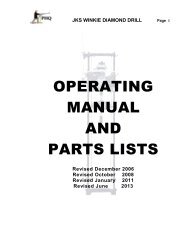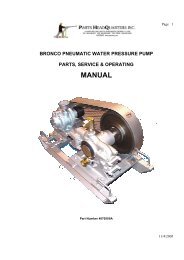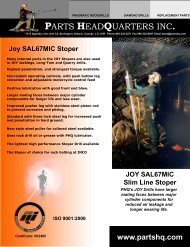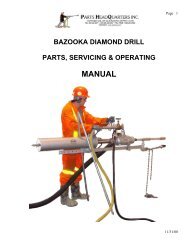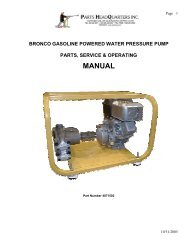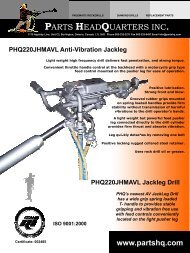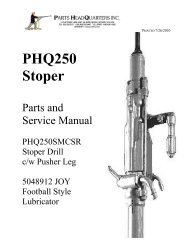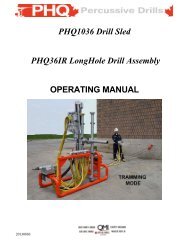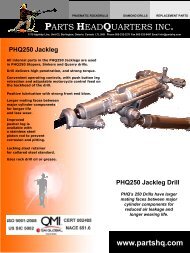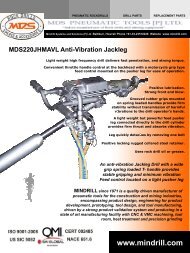PHQ250JHMAVL Jackleg MK 1 Parts and Repair Manual PDF
PHQ250JHMAVL Jackleg MK 1 Parts and Repair Manual PDF
PHQ250JHMAVL Jackleg MK 1 Parts and Repair Manual PDF
You also want an ePaper? Increase the reach of your titles
YUMPU automatically turns print PDFs into web optimized ePapers that Google loves.
Page 22<br />
Inspection <strong>and</strong> repair of the striking face of the Piston<br />
59. Inspect the striking face of the piston (B2334). If the striking face is not<br />
dished more than 1.0 mm (0.04 inch) you may reface the piston. Grinding<br />
of the face of pistons should be carried out in a proper machine shop where<br />
the piston is steadied in a turning jig to align the face to be ground square to<br />
the piston axis. The head must be quickly ground on a good belt grinder so<br />
that low heat is produced. Remove the raised portion <strong>and</strong> try to leave the<br />
original dished surface of the piston face. The piston should be replaced if<br />
the outer thickness of the splines at the front end are worn down to half the<br />
original size or if the piston striking face is chipped or cracked in any way.<br />
60. The case hardening on the face of the piston is approximately1.3 mm<br />
(0.050 inch) deep so that removal of material must not exceed 0.7 mm<br />
(0.040 inch). An “egg-shell” affect is created grinding the piston face by<br />
seriously reducing the case hardened depth. The life of a reconditioned<br />
piston can be expected to be about one half of what is normally expected<br />
performance. It is often more economical to replace worn pistons.<br />
Inspection of the fit of Piston (B2334) <strong>and</strong> the Cylinder (E393) (E393M) bore<br />
61. To establish consistency in testing always test the cylinder with inner<br />
surfaces of the cylinder bore <strong>and</strong> outside surfaces of the drill piston free from<br />
oil. The test relies on the “feel” of the fit <strong>and</strong> function of movement of the<br />
piston within the bore <strong>and</strong> the sounds generated during testing<br />
62 .The piston must be replaced when the head of the piston is worn down.<br />
Proper sophisticated measuring equipment to accurately gauge the wear on a<br />
piston head or in a cylinder bore is not available in most rockdrill service<br />
workshops. Cylinder <strong>and</strong> piston wear can be gauged by simple but effective<br />
established workshop practices. Place the cylinder so the font end is face down<br />
on a flat work bench. Align a new piston with the large head in the cylinder<br />
bore wrong way down. Always use a piston free of oil so that the comparison<br />
is always done under the same conditions. Grasp the splined end of the piston<br />
<strong>and</strong> slowly rock the piston back <strong>and</strong> forth in the cylinder to check the clearance.<br />
If the rocking motion of the striking end of the piston is greater than 3mm<br />
(0.12”) the cylinder is oversize. If the new piston is tight remove the new<br />
piston <strong>and</strong> replace with the used piston. If the same rocking motion is evident,<br />
it indicates that the piston is worn oversize <strong>and</strong> must be replaced.<br />
Version 200711



